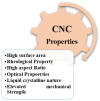Synthesis, Properties, Applications, and Future Prospective of Cellulose Nanocrystals
- PMID: 37896314
- PMCID: PMC10609962
- DOI: 10.3390/polym15204070
Synthesis, Properties, Applications, and Future Prospective of Cellulose Nanocrystals
Abstract
The exploration of nanocellulose has been aided by rapid nanotechnology and material science breakthroughs, resulting in their emergence as desired biomaterials. Nanocellulose has been thoroughly studied in various disciplines, including renewable energy, electronics, environment, food production, biomedicine, healthcare, and so on. Cellulose nanocrystal (CNC) is a part of the organic crystallization of macromolecular compounds found in bacteria's capsular polysaccharides and plant fibers. Owing to numerous reactive chemical groups on its surface, physical adsorption, surface grating, and chemical vapor deposition can all be used to increase its performance, which is the key reason for its wide range of applications. Cellulose nanocrystals (CNCs) have much potential as suitable matrices and advanced materials, and they have been utilized so far, both in terms of modifying and inventing uses for them. This work reviews CNC's synthesis, properties and various industrial applications. This review has also discussed the widespread applications of CNC as sensor, acoustic insulator, and fire retardant material.
Keywords: acoustic insulator; cellulose nanocrystal; fire retardant; nanotechnology; physical adsorption.
Conflict of interest statement
The authors have no particular conflict of interest.
Figures

















References
-
- Ray S.C. Applications of Graphene and Graphene-Oxide Based Nanomaterials. Elsevier; Amsterdam, The Netherlands: 2015. Application and uses of graphene oxide and reduced graphene oxide; pp. 39–55.
-
- Koshani R., Madadlou A. A viewpoint on the gastrointestinal fate of cellulose nanocrystals. Trends Food Sci. Technol. 2018;71:268–273. doi: 10.1016/j.tifs.2017.10.023. - DOI
-
- Kafy A., Akther A., Shishir I., Kim H.C., Yun Y., Kim J. Cellulose nanocrystal/graphene oxide composite film as humidity sensor. Sens. Actuators A Phys. 2016;247:221–226. doi: 10.1016/j.sna.2016.05.045. - DOI
-
- Jafary R., Khajeh Mehrizi M., Hekmatimoghaddam S.H., Jebali A. Antibacterial property of cellulose fabric finished by allicin-conjugated nanocellulose. J. Text. Inst. 2015;106:683–689. doi: 10.1080/00405000.2014.954780. - DOI
Publication types
Grants and funding
LinkOut - more resources
Full Text Sources

